Geography Test 1 Yr9
1/77
Earn XP
Name | Mastery | Learn | Test | Matching | Spaced |
|---|
No study sessions yet.
78 Terms
What are the 4 layers of the Earth?
The 4 structures of the inner core are the:
Crust - a solid, outer layer of rock broken into tectonic plates.
Mantle - a viscous, semi-molten layer beneath the crust, with convection currents causing tectonic plate movement.
Outer Core - a liquid, less-viscous iron and nickel layer, generating the Earth's magnetic field.
Inner Core - a 6000ºC, dense, solid centre of nickel and iron.
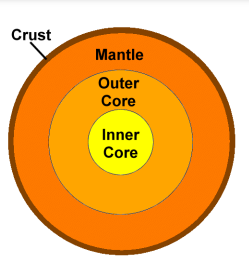
What is the crust?
The crust is a solid, outer layer of rock broken into tectonic plates.
What is the mantle?
The mantle is a viscous, semi-molten layer beneath the crust, with convection currents causing tectonic plate movement.
What is the outer core?
The outer core is a liquid, less-viscous iron and nickel layer beneath the mantle, generating the Earth's magnetic field.
What is the inner core?
What is evidence for tectonic theory?
Evidence for tectonic theory include:
Continental fit - the coastlines of continents appear to fit together like puzzle pieces, suggesting they were once joined.
Mountain chain links - mountain ranges on different continents align and appear to be part of the same chain.
Fossil matching - identical fossils of organisms are found on continents now separated by oceans, indicating they were once connected.
Geology matching - similar rock types and geological formations are found on continents that are now separated, supporting the idea they were once part of a single landmass.
Where do volcanoes usually occur?
Volcanoes usually occur at plate boundaries.
What is the Pacific Ring of Fire?
The Pacific Ring of Fire is the area where volcanoes are lined at plate boundaries near the Pacific Ocean.
What is a volcanic hotspot?
A volcanic hotspot is a volcano that has occurred away from a tectonic plate boundary.
What is an example of a volcanic hotspot?
An example of a volcanic hotspot is Mona Loa in Hawaii, where lava has solidified from exiting shield volcanoes.
Why do tectonic plates move?
Tectonic plates move due to the movement of magma as it is heated by the inner core at the centre of the Earth, causing it to rise.
As the magma gets further from the inner core, it cools and is pushed away by more magma rising from below.
Cooler magma then falls where it is heated again.
The circular movements of the magma are named ‘convection currents’ and they drag and push the tectonic plates above them.
How do volcanoes occur at destructive plate boundaries?
Due to convection currents, a lighter, less dense continental plate and a heavier, denser oceanic plate converge.
The oceanic plate is forced downwards, subducting under the continental plate which causes sedimental rock to buckle and fold causing fold mountains.
The force against the continental plate causes vents to form.
The oceanic plate melts due to the heat of the mantle and seeps into the continental plate’s vents.
The magma travels up these vents and the fold mountains and pressure is formed as the magma tries to escape.
A violent explosion of lava occurs, typically converting the fold mountain to a composite volcano.
How do volcanoes occur at constructive plate boundaries?
Due to convection currents, 2 plates diverge.
Magma ascends, filling the created gap.
The magma solidifies in water.
The number of layers of solidified lava accumulates to make a shield volcano above the surface.
There is no pressure for the magma to escape so shield volcanoes are not explosive but effusive.
How viscous is a shield volcano’s lava and what is it made of?
A shield volcano has low-viscosity lava so it is made from basalt.
How viscous is a composite volcano’s lava and what is it made of?
A composite volcano has high-viscosity lava so it is made from silica.
What were the primary effects of the Eyjafjallajökull eruption?
Ash clouds containing rock and glass were able to damage plane engines, so flights were cancelled and people were stranded.
Local town were damaged by lava and ash.
Local rivers were filled with ash and rock killing many species of animals.
Pyroclastic flows destroyed nearby forests, leaving animals with no habitat.
What were the secondary effects of the Eyjafjallajökull eruption?
Due to ask and rock being in rivers, flooding occurred, causing risk to people and property.
Due to pyroclastic flows destroying habitats and rivers containing ask and rock, local wildlife began to die out in massive numbers as their habitat and sources of food were buried.
Due to being stranded, students were unable to go to school for education and people were homesick from being away from family.
Due to property damage, people were forced to live in temporary accommodation, damaging their mental health as they are forced to rebuild their lives.
Why do people live near volcanoes?
Fertile soils good for agriculture - minerals are brought to the surface during eruptions in lava., which can provide minerals to the soil, adding quality to the soil.
Tourism - volcanic areas are popular for tourism so new jobs are created to cater them.
Geothermal energy - water is pumped down into hot volcanic rock deep is is converted to steam. When the steam reaches the surface, it is used to turn large turbines to create energy, which is cheaper than non-renewable energy.
Mineral extraction - precious metals and minerals are brought to the surface during eruptions so many mining industries are set up near volcanoes which creates many jobs.
What is a coastline?
A coastline is the outline of the land where it meets the sea.
What are waves?
Waves are wind driving water.
What is the wavelength?
The wavelength is the horizontal distance between 2 wave crests.
What is the wave-height?
The wave-height is the vertical distance from the wave trough to the crest.
What is a wave crest?
A wave crest is the top of a wave.
What is a wave trough?
A wave trough is the base of a wave.
What is the wave fetch?
The wave fetch is the distance of water over which the wind blows.
What is a swash?
A swash is water and sediment ascending a beach from breaking waves.
What is a backwash?
A backwash is water flowing back to sea after a wave breaks.
What is erosion?
Erosion is the removal of material by a moving force such as a wave or a river.
What are the 4 main types of erosion?
The 4 main types of erosion are:
Hydraulic Action - the force of waves compressing air in cracks, creating pressure that decomposes rock.
Abrasion - sediment from hydraulic action falling into a wave grinding and chipping away at a cliff causing the decomposition of rock.
Corrosion - some types of rocks chemically reacting with saltwater causing decomposition.
Attrition - rocks colliding with each other, turning them smaller, smoother and rounder.
What is weathering?
Weathering is the decomposition of rock caused by day-to-day atmospheric changes.
What are the 4 main types of weathering?
The 4 main types of weathering are:
Mechanical Freeze Thawing - water in vents freezing overnight and expands the vent, turning liquid in the morning to make a cycle.
Mechanical Wetting/Drying - soft rocks such as clay expanding when wet and contracting when dry which forms vents.
Biological - root growth and burrowing animals decomposing rock.
Chemical Carbonation - CO2 and SO2 mixing with rainwater to produce acid rain which decomposes rocks.
What is longshore drift?
Longshore drift is the transportation of sediment along a beach in the direction of prevailing winds and waves.
What is transportation?
Transportation is the movement of sediment along a beach.
What is deposition?
Deposition is the dropping of sediment when waves lose energy in sheltered bays with constructive waves or where groynes trap sediment.
What is infiltration?
Infiltration is water entering the ground.
What is saturation?
Saturation is when rock becomes full of liquid.
What is impermeable rock?
Impermeable rock are porous rocks that do not allow liquid to pass through.
What is permeable rock?
Permeable rock are non-porous rocks that allow liquid to pass through.
What is a slip plane?
A slip plane is a line of weakness along which movement occurs.
What is mass movement?
The downhill movement of material caused by gravity which can be caused by weathering and erosion weakening the cliff, making it unstable.
What is slumping?
Slumping occurs when saturated material descends a slope along a curved slip plane.
What is rock fall?
Rock fall occurs when rocks fall vertically down a cliff due to gravity
What is a landslide?
A landslide involves rock, soil and mud descending a slope due to heavy rainfall and gravity.
How does a landslide occur?
Heavy rain saturates the soil and rock, making it heavier.
A slip plane forms.
The saturated material falls along the slip plane.
How are waves formed and broken?
Waves are formed by winds creating friction on the sea surface, moving water in circular motions.
Waves are broken when they enter shallow water, causing friction with the seabed, slowing the wave’s base while the top moves faster.
What are constructive waves?
Constructive waves:
Have a low wavelength and height.
Have a strong swash and gentle backwash that add material to create beaches.
Are formed in calm weather and a short fetch.
What are destructive waves?
Destructive waves:
Have a short wavelength and a large height.
Have a weak swash and strong backwash removing material.
Are formed in stormy weather and a long fetch.
What are beaches?
Beaches are deposits of sand and shingle at a coastline.
What are the 2 types of beaches and how do they form?
The 2 types of beaches are:
Sandy Beaches - wide and flat beaches formed by constructive waves in sheltered area.
Pebble Beaches - steep and narrow beaches formed by destructive waves.
What are wave-cut platforms?
Wave-cut platforms are flat, horizontal rock surfaces found at the base of cliffs, formed by the erosive action of waves over time.
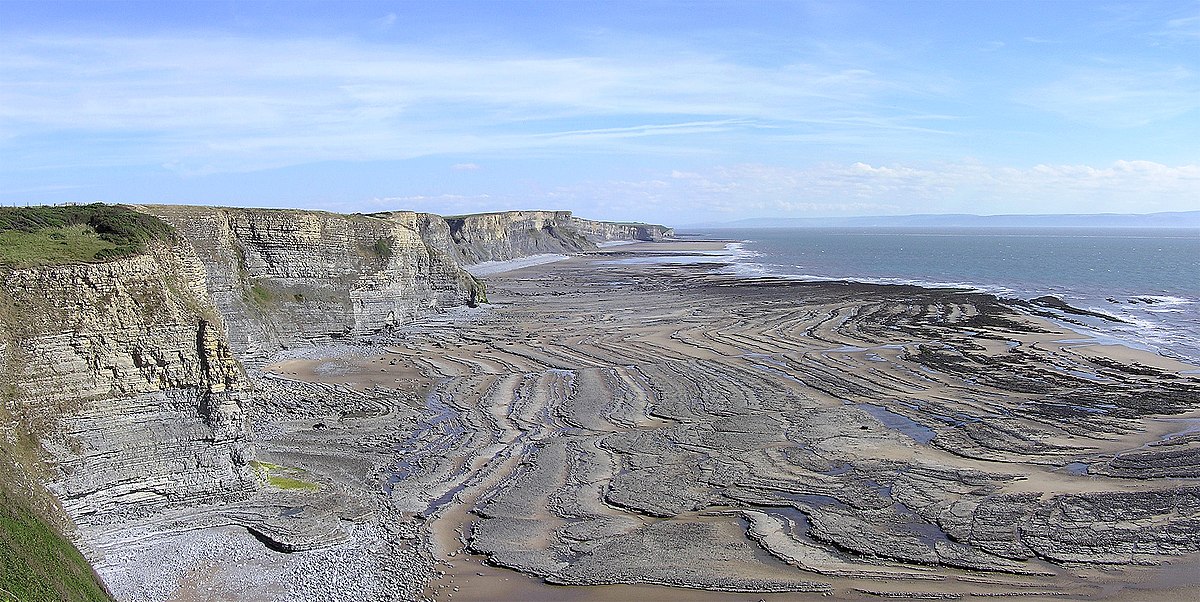
How are wave-cut platforms formed?
Waves erode the base of the cliff between high and low tide levels, forming a wave-cut notch.
Continued erosion enlarges the notch, making the overhanging cliff unstable.
The overhanging cliff collapses, leaving a wave cut platform.
The cliff retreats inland as this process continues.
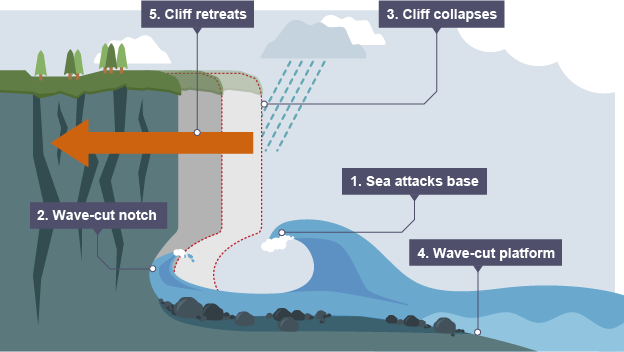
What are headlands?
Headlands are cliffs sticking out to sea.
What are bays?
Bays are indentations in the coastline between headlands.
What are discordant coastlines?
Discordant coastlines are coastlines where sections of more and less resistant rock run perpendicular to the shore.
The more-resistant rock erodes slower so it becomes a headland.
The less-resistant rock erodes faster so it becomes a bay.
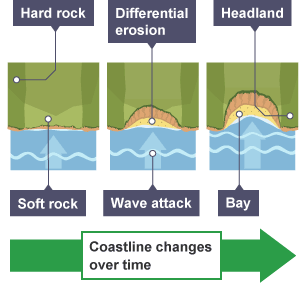
What are examples of more-resistant rock?
Examples of more-resistant rock include:
Granite
Basalt
Limestone
What are examples of less-resistant rock?
Examples of less-resistant rock include:
Clay
Chalk
Limestone
Why are beaches formed at bays?
Beaches are formed at bays as they are sheltered, so deposition is performed.
What is wave refraction?
Wave refraction is wave energy bending around a headland and crashing into its sides.
How are caves, arches, stacks and stumps formed?
Erosion processes from wave refraction widen bedding planes and joints in the cliff, creating a cave.
Erosion from wave refraction continues and since erosion is also occurring at the other side, the two ends meet, forming an arch.
Weathering processes weaken the top of the arch, so the arch collapses to form a stack.
The stack is eroded form wave refraction from the base by the sea and weaken at the top by weathering, forming a blunt, short stump.
What is an example of a coastline where stumps have been formed?
Old Harry’s Rock:
Erosion attacked the base of chalk cliffs, forming caves.
The caves widened and became arches.
The arches collapsed, leaving stacks.
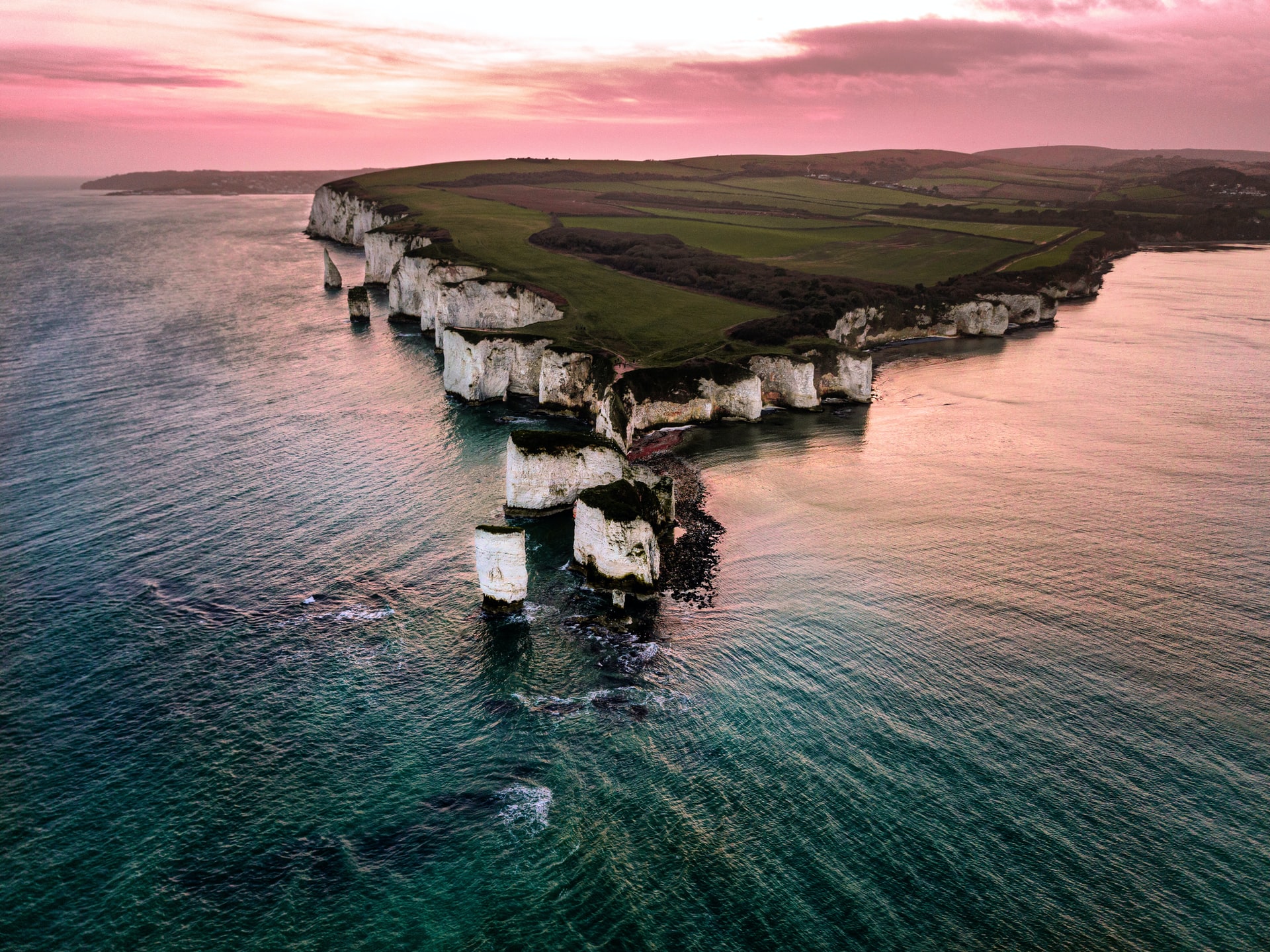
How are spits formed?
Longshore drift moves sand or shingle along the coastline.
When the coastline changes direction, sediment is deposited.
Over time, the deposited material builds up, forming a narrow, hooked landform.
The result is a spit, which extends into the sea, which is often curved due to wind.
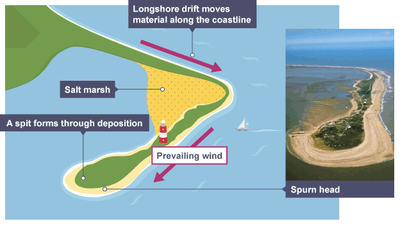
How are bars formed?
Bars are formed by a spit growing across a bay, trapping water behind to form a freshwater lake.
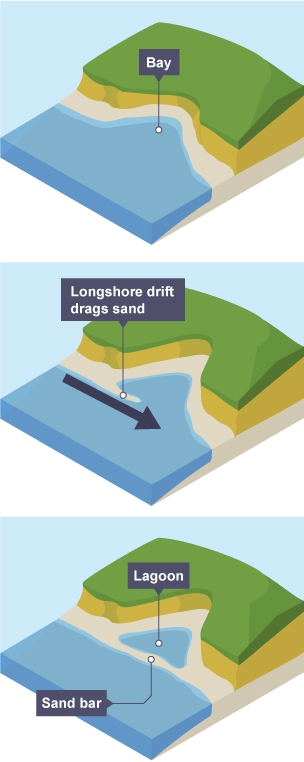
How are tombolos formed?
Tombolas are formed when a longshore drift connects a spit to an island.
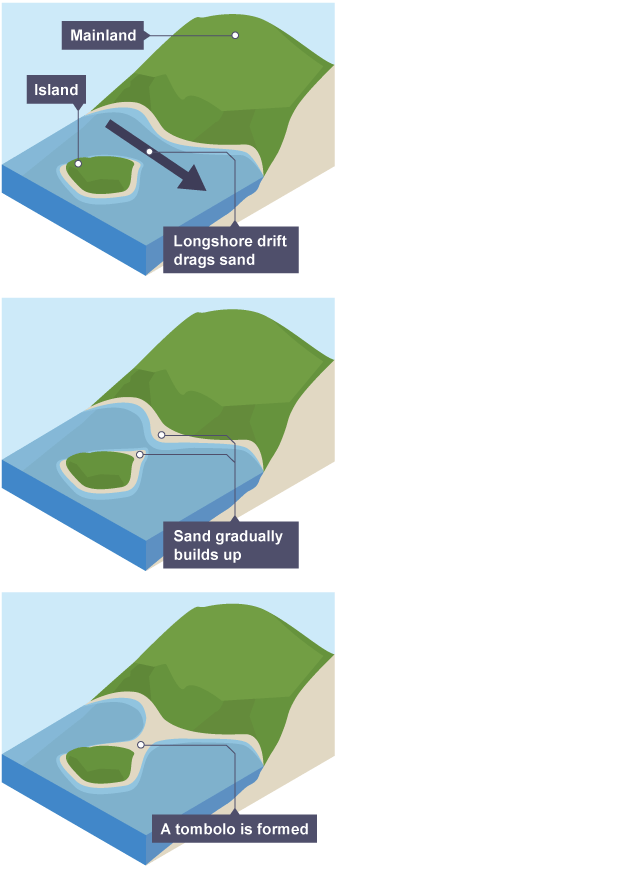
What is an example of a tombolo?
Chesil Beach joining to Portland is an example of a tombola.
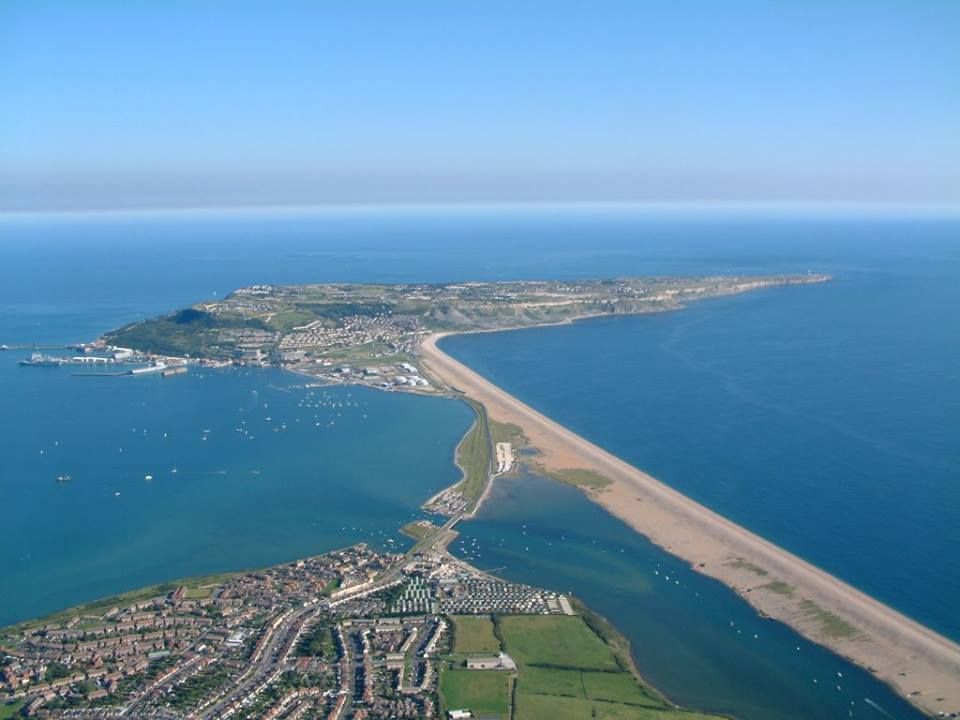
What is required to protect a section of coastline?
For a section of coastline to be protected, the cost of the scheme must be less than the value of the land, property and infrastructure saved.
What are shoreline management plans?
Shoreline management plans are created by the British Government that outline how our coastline will be protected.
What are the strategies to protect our coast?
Advance the Line: Build new defences in front of existing ones for high-value areas.
Hold the Line: Maintain/improve current defences to protect valuable land.
Managed Realignment: Allow the sea to flood low-value land until it comes to a natural barrier of higher land to save funding.
Do Nothing: Let natural processes shape low-value areas to save funding.
What is hard engineering?
Hard engineering is using man-made, artificial structures to prevent erosion and flooding.
What are the advantages and disadvantages of the types of hard engineering?
Sea Wall: Absorbs wave energy; effective but costly and unnatural.
Rock Armour: Boulders protect cliffs; natural-looking but expensive.
Groynes: Barriers trap sediment; boost tourism but shift erosion downstream.
Gabions: Wire cages filled with rocks; cheap but short-lived.
Off-shore Breakwater: Stone walls built parallel to the coastline to reduce wave energy, promote deposition, and create larger beaches; effective but expensive and may interfere with boats.
What is soft engineering?
Soft engineering is using natural environmentally-friendly methods to prevent erosion and flooding.
What are the advantages and disadvantages of the types of soft engineering?
Beach Nourishment: Adds sediment to widen beaches; cheap but requires maintenance.
Dune Regeneration: Marram grass stabilizes dunes; natural but time-intensive.
Beach Reprofiling: Returning removed material to the beach to prevent shrinkage; it's cheap and natural-looking but needs frequent maintenance and causes temporary closures.
Dune Fencing: Fences trap sand to create dunes; effective but fragile.
What is the general difference between soft and hard engineering?
Hard engineering is more effective, long-lasting and requires less maintaining but is costly and less natural.
Soft engineering is less effective, requires more maintenance and is shorter lasting but is cheaper.
What are sand dunes?
Sand dunes are mounds of sand at the back of a beach where material has been blown inland and deposited near obstacles and collected.
What were the positive outcomes of the coastal management phases at Lyme Regis?
The new beaches increased visitor numbers.
The new defences have stood up to recent stormy conditions.
The harbour is better protected, benefitting boat-owners and fishermen.
What were the negative outcomes of the coastal management phases at Lyme Regis?
Increased visitors meant conflict over congestion and litter between locals and residents.
The new defences are unaesthetically pleasing.
The new sea wall may interfere with coastal processes affecting other stretches of coastline from receiving sediment.
What is a managed retreat?
A managed retreat is a deliberated decision to allow the sea to flood an area of low-value land.
What were the advantages of the Medmerry Managed Retreat?
Created a large saltmarsh protecting the most expensive inland areas from flooding.
Created wildlife habitats.
Cheaper than repairing the sea wall.
What were the disadvantages of the Medmerry Managed Retreat?
People and businesses were flooded and relocated, costing the government £28M.
Large areas of agricultural land was lost.